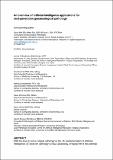An overview of artificial intelligence applications for next-generation gynaecological pathology
Abstract
With the drive to roll out digital pathology in the UK, implementation of artificial intelligence (AI) tools for pathology is now a possibility, bringing with it the potential to change how we work as a specialty. AI promises many benefits for working practices such as improved efficiency and consistency, financial and productivity gains and ultimately a better service for our patients. Gynaecological pathology is a diverse specialty with many potential avenues for algorithm development, yet there are relatively few nearing clinical validation compared to other pathology specialties. This article provides a summary of the current landscape of AI in pathology with a focus on applications in gynaecological pathology. We discuss the ways pathologists can be involved in algorithm development and draw on our significant experiences in a nationally funded programme for AI development and research. Finally we look to what the future might hold.
Citation
Bell , S , Blackwood , J D , Fell , C , Mohammadi , M , Morrison , D , Harris-Birtill , D & Bryson , G 2023 , ' An overview of artificial intelligence applications for next-generation gynaecological pathology ' , Diagnostic Histopathology , vol. 29 , no. 10 , pp. 442-449 . https://doi.org/10.1016/j.mpdhp.2023.07.002
Publication
Diagnostic Histopathology
Status
Peer reviewed
ISSN
1756-2317Type
Journal article
Description
Funding: The work described in the section Creation of a Scottish ‘living lab’ for AI development is part of iCAIRD which is funded by Innovate UK on behalf of UK Research and Innovation (UKRI), project number 104690.Collections
Items in the St Andrews Research Repository are protected by copyright, with all rights reserved, unless otherwise indicated.
Related items
Showing items related by title, author, creator and subject.
-
Next-generation pathology
Caie, Peter D; Harrison, David J (Humana Press, 2016) - Book itemThe field of pathology is rapidly transforming from a semiquantitative and empirical science toward a big data discipline. Large data sets from across multiple omics fields may now be extracted from a patient's tissue ... -
The differential expression of micro-RNAs 21, 200c, 204, 205, and 211 in benign, dysplastic and malignant melanocytic lesions and critical evaluation of their role as diagnostic biomarkers
Quiohilag, Katherine; Caie, Peter; Oniscu, Anca; Brenn, Thomas; Harrison, David (2020-05-09) - Journal articleOverlapping histological features between benign and malignant lesions and a lack of firm diagnostic criteria for malignancy result in high rates of inter-observer variation in the diagnosis of melanocytic lesions. We aimed ... -
Locomotor deficits in a mouse model of ALS are paralleled by loss of V1-interneuron connections onto fast motor neurons
Allodi, Ilary; Montañana-Rosell, Roser; Selvan, Raghavendra; Löw, Peter; Kiehn, Ole (2021-05-31) - Journal articleALS is characterized by progressive inability to execute movements. Motor neurons innervating fast-twitch muscle-fibers preferentially degenerate. The reason for this differential vulnerability and its consequences on motor ...

